 |
|
| The Borochov neighborhood -
named after Dov Borochov and initiated by David Schneiderman who had arrived during the Second Aliyah , was established in 1922.
Dov Borochov was one of the founders of the Labor Zionist movement. Borochov neighborhood was the first workers' neighborhood in the country and where the first cooperative grocery store was established.
The Borochov neighborhood - Hava Haruvi Reminiscences 1922 When the neighborhood was established, 22 houses were built with the help of various organizations and another 28 houses were built independently. Our house was built without the help from any organization and thus was the first one completed. The plots were divided among the member based on a bid. A wadi ran thru our plot and we could move into our house only after the wadi was sealed. So, at first we had to live in a tent. After we finally moved into our house, we used blankets to close the windows and doors. Our two children, Sara and Yosk'e, were sick with Typhoid fever, which made it even worse. As I really wanted to live on a settlement, the neighborhood was a compromise. In our Auxiliary Farm we had a dairy barn, chickens, a vegetable garden and a little orchard. Natan was involved in public matters in the "Haganah" ("The defense" - a Jewish paramilitary organization ) and "Members' Trials". He also devoted time to the cooperative grocery store "Tzarchania" and "Mis'ad - The Mutual Aid Fund" which became the local branch of "Bank HaPoalim". Our house served as a family absorption center. Immigrants stayed in our house during their first period in the country. We helped them find accommodations and employment. There was a special ambience in the Borochov Neighborhood. A whole generation was influenced by The Socialist Education Movement providing Hebrew and Zionist education, including pioneer, agriculture and labor education. "The school" and the "Youth movement" were working together in cooperation. 10 years after it was established, the neighborhood started to change and with the urban impact joined its neighbor and became part of the local council of Giv'atayim, which later on became a city.
The vegetable garden in the workers neighborhood The vegetable garden should make up the largest part of the plot in the workers neighborhood, taking into account the country's climate, especially in the Sharon area which is near the coast. The garden will supply all the vegetables needed for each household all year round. Every vegetable has its season. Each family will save money on their household expenses. Radish, small radish, carrot, beet, tomatoe and eggplants - grow 8-9 months a year. Cabbage and cucumber - twice a year. Onion, garlic and legumes - grow all year round. Each family could grow vegetables for their own use and for marketing. We had to define the preconditions for the workers before starting the vegetable gardens - 1. Gated soil, free of couch grass 2. Sufficient irrigation 3. Professional training 4. Organized surplus produce marketing Even those working in the city could create a vegetable garden in their lot with these conditions. Working in the city takes all together about 10 hours of the day, so there is still enough time to work the garden each day. Any member in the working neighborhood who is employed in the city, will need a lot of about two and a half dunams. The lot should be divided into a few sections - Half a dunam for the house, the cowshed and the chicken coop. The rest of the land should be devoted partly to banana plantations and vineyards and partly to other fruit trees. In between both parts - a vegetable garden. The method of planting vegetables among trees was already customary in Damascus area as well as in other places, where water could be supplied by irrigation. This method can also be implemented in our country, as there is enough sun for growing vegetables. Each neighborhood member can purchase at least one simple cow and can raise about 50 chickens thru out the year. This might benefit milk, eggs and fertilizers. Growing vegetables all year round will contribute to the saving on household expenses.
The water problem in the Borohov Neighborhood Water supply has been a big problem in the Borohov Neighborhood. Both parts of the neighborhood had to rely on "Ir Ganim" and "Nahalat Yitzhak". The residents of the neighborhood were forced to solve the water supply problem on their own, as all their efforts to get loans from the national and "HaHistadrut" (The General Federation of Laborers) institutions were in vain. In 1926, the first well was dug and the residents could supply their own water. In 1927, the neighborhood members finally celebrated the removal of threats to their water availability.
The 1929 riots (Meora'ot Tarpat) The " Eisen House" in the Borohov neighborhood accommodated the headquarters. The guarded headquarters were connected to the positions by runners. Even the hills were occupied. Every rifle and bullet were of great value. We had dirty Bedouin-guns which we had to clean, we learned how to distinguish among the different weapons, disassemble, put them back together and sort thru them. When we first saw "The Schwarzlose" we cherished it. It was a water-cooled, medium machine-gun, belt-fed weapon. We were very proud to have a machine gun and we kept it hidden. We used "The Schwarzlose" with the riots outbreak in 1929 during the attack on The Montefiore neighborhood. Isaac (Joshua Eshel) who was living at the time in the neighborhood, provided us with a Mauser semi-automatic rifle with 50 bullets. Since he had accumulated expertise in such weapons, he was chosen to be head of "The Flying Group". The Flying Group's task was to provide help when necessary since they had the required weapons for this purpose.
"HaNoar HaOved" (The Working Youth) branch establishment With the growth of the neighborhood, the youth movement "HaNoar HaOved" was established. There were other youth movements as well, considered to be part of the Tel-Aviv branch, but eventually, an independent branch of "HaNoar HaOved" was established. It became on of the most important branched of The Federation of Working Youth, in terms of its size and scope of values. The school in the Borohov Neighborhood |
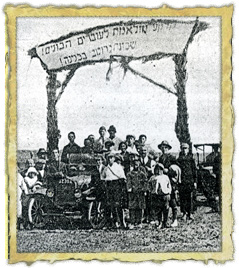 Borochov neighborhood - The start |
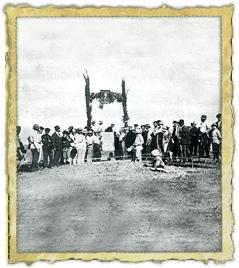 |
| Borochov neighborhood celebration 1922 |
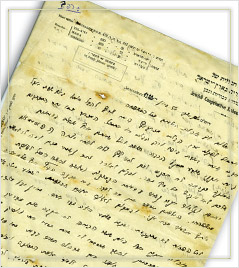 |
Letter from Natan to Hava - From Jerusalem to Kefar Yehezkel |
 |
Letter from Hava to Natan- From Kefar Yehezkel to Jerusalem |
 |
Building the water tower in the neighborhood |
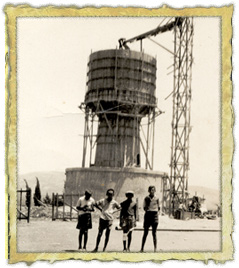 |
Building the water tower in the neighborhood |
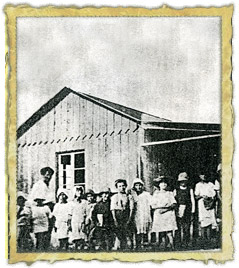 |
| The first house |
 |
| Work in school garden, Sara Haruvi at 5th grade with white kafiya on the left bottom corner |








